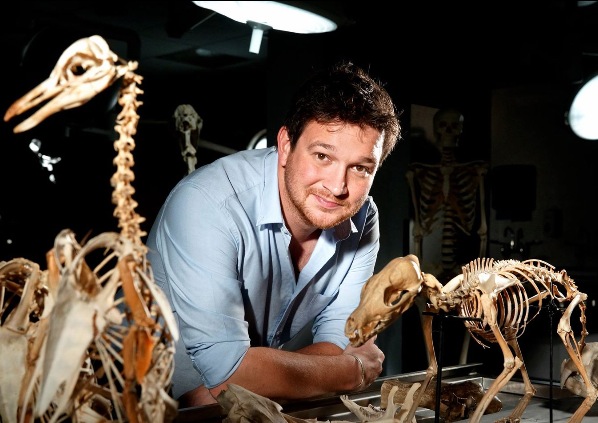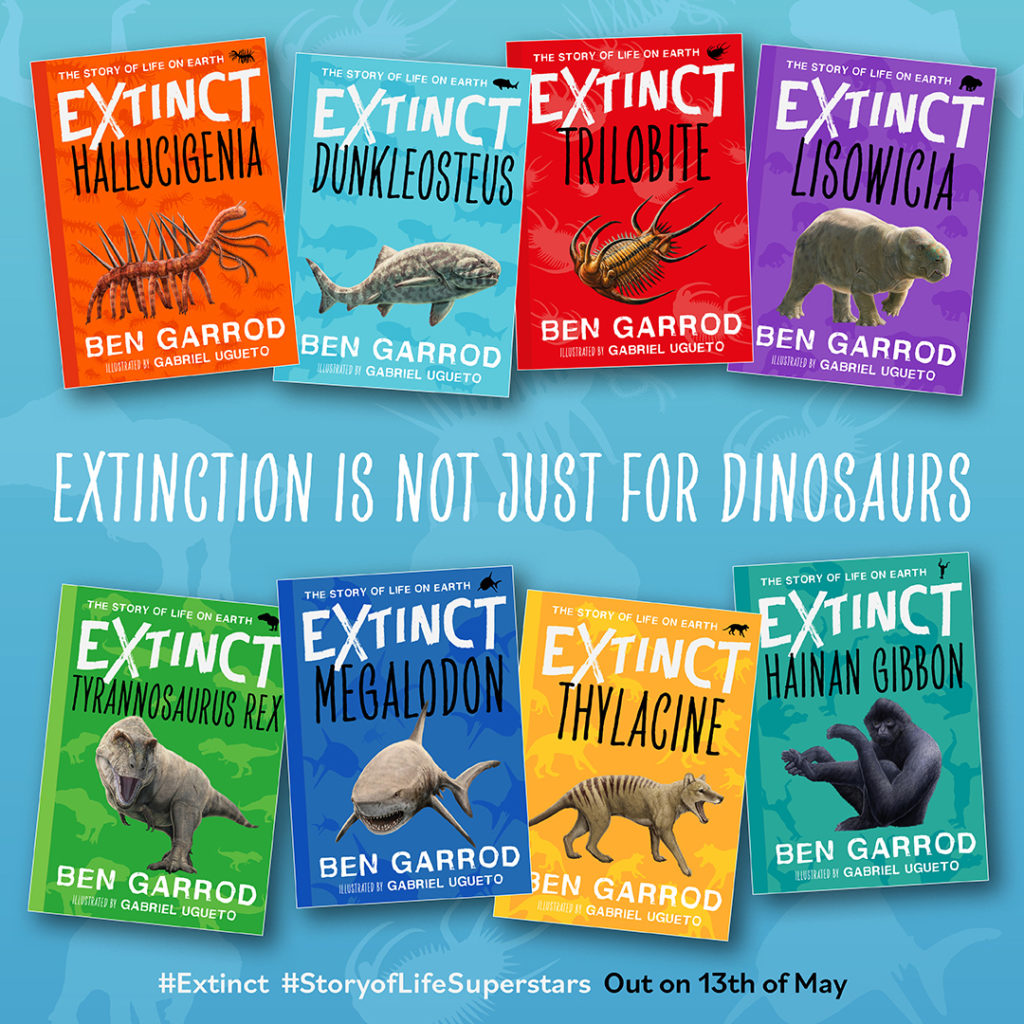Your cart is currently empty!

Professor
Ben Garrod
When we think of extinct animals, it’s all too easy to think about huge dinosaur skeletons in museums, completely intact and cleaned up. The reality however, is very different. Most fossil discoveries, even from big species which lived just 70 million years ago, such as the ever-so-famous T. rex, are often pieces and fragments.
Ben Garrod

A truly gripping and awe-inspiring series of books. Professor Garrod takes us on a journey of evolution and extinction, dating back hundreds of millions of years. From rapid mass extinctions via devastating volcanoes to extinctions lasting millions of years. Meet incredible creatures such as Hallucigenia and the formidable Dunkleosteus along the way. An awesome way in which to learn tons and have a great time doing it.
I’d like to thank Ben Garrod for joining us in the VIP Reading blog to talk about his latest book series, Extinct.
You write about various things happening millions of years ago, such as carbon dioxide levels dropping massively. How is it possible to know these things when they happened so long ago?
We know this, and much more, because science, and scientists, are awesome, basically. We have so many incredible techniques which we can use to unlock secrets from unbelievable fossil discoveries. We can do things, which vary from looking at rates of breakdown in radioactive elements in prehistoric bones which help us detect what the atmosphere was like, to analysing the internal structures of rocks to look for the unique types of crystals created by an asteroid impact. The exciting thing is that we are developing new techniques and finding new fossils every day, so our understanding is always growing.
How sure can scientists be that the different fossil fragments they are piecing together actually go together?
Ha ha, they’re not always sure, and in many ways, that’s part of the scientific process. When we think of extinct animals, it’s all too easy to think about huge dinosaur skeletons in museums, completely intact and cleaned up. The reality however, is very different. Most fossil discoveries, even from big species which lived just 70 million years ago, such as the ever-so-famous T. rex, are often pieces and fragments. Imagine how much more difficult this is with a small fossilised species. A small species which lived hundreds of millions of years ago will be even harder to piece together. Plus if that small species lived hundreds of millions of years ago, and was soft-bodied and had no skeleton, then it’s almost impossible to be certain about what it looked like and how it behaved. It was decades after its discovery that we finally understood what Hallucigenia, the small worm-like animal from nearly half a billion years ago looked like.
What is the most fascinating fossil you are aware of and why?
That’s such a tough question to answer. There are so many fantastic fossils which tell us so much. There’s a very famous fossil for example called the ‘Fighting Dinosaurs’, which shows a Velociraptor and Protoceratops which both died while fighting. For me, it’s the fossils that aren’t famous that fascinate me the most. In my local museum in Bristol, there’s a Scelidosaurus fossil. This armoured herbivore, lived during the Jurassic period, and is so well-preserved, you can still see the food in its throat 190 million years after it died.
If you could take a walk during any period from prehistoric history, when would it be and why?
These questions are all so difficult to answer! I’d love to go back to see what it was like at many points in prehistory. I’d like two stops in my time-travel adventure, if that’s okay. First, I’d stop around 101 million years ago and head to Argentina to see the mighty long-necked, long-tailed herbivore Patagotitan which, at somewhere between 55-75 tonnes, may have been the largest land animal ever. My other stop would be in East Africa, around three million years ago. I’m fascinated by our early human ancestors and would love to see what we were like then. We were at a pivotal moment, where climate change had completely altered habitats, turning endless forest into much drier grasslands. With that came massive changes to our anatomy and behaviour, all leading us to where we are today.
With all we know of the evolutionary history of the world, what are your predictions for the evolutionary future?
That’s a dangerous game to play ha ha … Evolution is unpredictable and wild and just because you can look back to see what has happened in the past, does not mean you can predict what’s coming next. If we were suddenly zapped back in time to when the dinosaurs roamed the planet, there is no way anyone would ever have been able to say that one day, in the blink of an eye in geological terms, some weird, hairy, little ape would move down from the trees, lose its hair, learn how to make and use tools and would come to dominate the planet as we do. Predicting evolution and expecting it to happen that way is a game for suckers. The beauty of evolution is that you never know what’s coming next.
The world has experienced several mass extinctions in its history. Do you predict another one any time soon (relatively speaking)?
Just look around you. At least one million species are endangered right now …
Who would win, Dunkleosteus or Megalodon?
Ah, that’s easy.
If you were able to bring back one extinct creature, what would it be and why?
I never use the word ‘creature’ as it implies it was created and for that, you need a creator. Instead, species evolve as a result of a never-ending supply of random mutations, the effects of their surroundings and their interactions with other species. It may sound controversial, but I wouldn’t bring any extinct species back. That’s the easy option. Instead, every species we’ve lost should serve as a reminder to us that extinction is forever, and now, more than ever, our actions have consequences.
If someone wanted to follow in your footsteps, what advice would you give them?
Be weird, be geeky, be different, and definitely don’t follow in my footsteps! Instead, make your own footprints and have fun on your own journey. I’ll give you the advice my mum gave me when I was much younger. Find a career where you wake up each day and look forward to the day ahead, because you love what you do so much. I love what I do, but I’ve tried lots of things along the way. I’ve tried different jobs, have lived in different parts of the world and have changed more than a few times now. You only have one life, so take the time you need to make sure you spend that life doing what you love. Also, don’t be too mature all the time. Remember to be silly!
What’s next? More books in the Extinct series? A new series? Or something completely different?
There are eight books in my Extinct series, which will be coming out over the next 12 months. Each book tells the amazing story of a mass extinction and one of the animals lost each time, from the largest shark to the most successful animals that have ever lived. As well as these books, I’m always at work on more ideas and have some exciting TV and radio projects in development. I’d love to tell you all about them, but they’re secret and you’ll just have to wait and see what they are …
Can you describe the Extinct series in three words?
Life keeps going.

Q & A hosted by
Ben Morgan